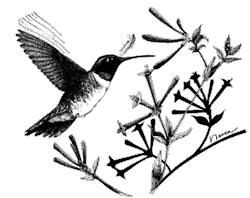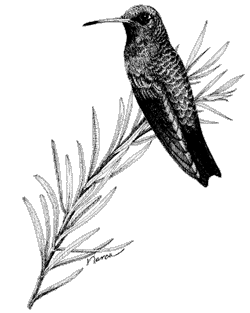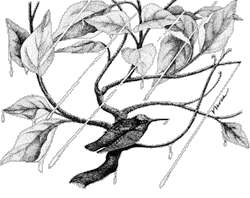Hummingbirds
Describing hummingbirds without resorting to superlatives would be difficult, and hardly fair. This family includes the world's smallest birds, with the most brilliant iridescent colors, the fastest wingbeats, and the most amazing ability to fly up, down, sideways, and backwards. They spend their days hovering at flowers to sip nectar, feeding almost constantly to supply the sugar necessary to maintain their racing metabolism. Many people would call these the world's most fascinating birds.

Black-chinned Hummingbird
The brightest colors and most ornate patterns among hummingbirds are worn by males, and the purpose is evidently to impress females. After mating, the male takes no more part in family life. The female alone builds the nest, incubates the tiny eggs, and feeds the young. Considering the amount of energy that an individual hummingbird needs just to feed itself, it seems remarkable that the female is able to raise the young successfully all alone.
There are well over three hundred species of hummingbirds, all native to the Americas. The vast majority, not surprisingly, are found in the tropics, where flowers abound year-round. Only a handful of species reach the United States; southern Arizona hosts more than a dozen of those. Costa’s Hummingbird is the only true desert hummer here, but several others live along the desert's edges. Black-chinned and Broad-billed Hummingbirds nest in streamside woods in summer, while Anna’s Hummingbird, a recent invader from California, nests in the same areas (and in residential neighborhoods) in winter. Our region hosts the greatest variety of hummers in late summer, when several species are on their way south. Rufous Hummingbirds, southbound from nesting grounds in the northwest U.S., may appear in the Sonoran Desert by July, along with lesser numbers of other species, to joust for space around the blooms that follow the summer rains.
Hummingbirds
Representative Sonoran Desert species:
Broad-billed Hummingbird (Cynanthus latirostris)
Black-chinned Hummingbird (Archilochus alexandri)
Anna’s Hummingbird (Calypte anna)
Costas Hummingbird (Calypte costae)
Rufous Hummingbird (Selasphorus rufus)
Order: Apodiformes
Family: Trochilidae
Spanish names: chuparrosa (hummingbird), chuparrosa matraquita (Broad-billed
Hummingbird), chupamirto garganti-negro (Black- chinned Hummingbird),
chupamirto cuello escarlata (Anna’s Hummingbird), chupamirto garganta
violeta (Costa’s Hummingbird), chupaflor dorado (Rufous Hummingbird)
Description
The smallest birds in the world belong to this family. In our region, they range in length from 2¼ inches to 5 inches (7 to 13 cm), and from 2 g to 10 g in weight. All in our region have long, pointed beaks for probing flowers for nectar, saber-like wings for hovering in front of flowers, a generally iridescent bronze or green dorsal surface, and primarily in males, bright, colorful throat and head patches. The iridescent throat patch is called the gorget (pronounced gore-jet).
Distinguishing Features

Rufous Hummingbird
Broad-billed Hummingbird: 4 inches (10 cm) in length; 3 g to 4¼ g in weight. In poor light the males appear dark with red bills and forked tails. In good light, the males head and breast are metallic blue or blue-green. The females are a duller grey-green, but retain the dark forked tail and have red only at the base of the lower mandible.
Listen to Broad-billed Hummingbird sounds
Black-chinned Hummingbird: 3¼ inches (9 cm) in length; 3 to 4 g in weight. This hummingbird is iridescent green above and gray below. The male has a velvet black throat, the bottom border of which iridesces violet in good light. The dark throat patch contrasts strongly with a white upper breast, giving a collared effect. The females lack dark throat patches.
Anna’s Hummingbird: 4 inches (10 cm) in length; 3¼ g to 5 g in weight. These “flame-throated” hummingbirds are iridescent green above and grey below. In addition, the male's throat and forehead iridesce crimson rose in good light; in poor light, these areas appear to be velvety black. The females generally lack these iridescent rosy patches, but may have a few rose feathers on the throat.
Listen to Anna’s Hummingbird sounds
Costa’s hummingbird: 3¼ inches (9 cm) in length; 2¼ g to 3¼ g in weight. This “flame-throated” hummingbird is iridescent green above and grayish white below. The males in good light have an iridescent amethyst purple forehead and throat. The iridescent throat patch extends into an elongated “mustache.” In poor light, these patches appear velvety black. The female completely lacks these patches.
Listen to Costa’s Hummingbird sounds
Rufous Hummingbird: 3¼ (9 cm) inches in length; 3 g to 4 g in weight. The male is cinnamon-rufous on the upper parts, tail, and lower breast and belly. In good light, the throat iridesces a metallic orange to scarlet. The female is iridescent bronze-green above and dull white below. She also has a cinnamon wash to the flanks and much rufous on all the tail feathers.
Habitat

Broad-billed Hummingbird
Hummingbirds occupy most temperate and tropical habitats in the western hemisphere. In our region, they can be found in desert, grassland, woodland, and forest. They tend to prefer edges of dense habitats, and the scrubbier areas of open habitats.
- Broad-billed Hummingbird:
- In Arizona and Sonora, the broad-bill is found in the lower mountain canyons and in the mesquite bosques of the larger washes and rivers. Habitats also include the thorn forest and thornscrub of southern Sonora.
- Black-chinned Hummingbird:
- This is the “summer hummer” in southern Arizona. The bird winters in Mexico. In Arizona, the Black-chin inhabits deciduous woodland associations in low mountain canyons, desert riparian habitats, and cities. It is generally absent from desertscrub.
- Anna’s Hummingbird:
- The Anna’s Hummingbird is generally considered a sedentary resident bird of the Pacific Slope, west of the Sierra Nevada Mountains, with some birds visiting southern Arizona and northern Sonora in the fall and winter. Since the 1960s the number of fall and winter visitors to Arizona has increased greatly, as has the number of breeding birds in our area. The first nesting in Arizona occurred in 1962. In Arizona, Anna’s Hummingbirds are found in residential areas most commonly in association with feeders and exotic plantings. They can also be found in desertscrub and riparian woodland.
- Costa’s Hummingbird:
- This hummingbird inhabits desertscrub communities dominated by cactus, ocotillo, chuparosa, and wolfberry. It is probably our most arid-adapted hummingbird.
- Rufous hummingbird
- This hummingbird breeds in the northwestern United States and western Canada and winters in Mexico. It tends to migrate north through western Sonora, western Arizona, to the Pacific coast; it tends to migrate south through the Rocky Mountains, including eastern Arizona. This annual migration path forms a broad oval over most of western North America. The males generally migrate before females and immatures. During migration in Arizona and Sonora, the Rufous uses a wide variety of habitats from desertscrub to mountain meadows, wherever there are flowers or feeders.

Anna’s Humingbird
Feeding
Hummingbirds are the dominant nectarivorous birds in the western hemisphere. Old World ecological equivalents include the honey-eaters of Australia and the sunbirds of Africa. Although many of these other birds may have specialized bill shapes and foot types for getting nectar, and some have bright or iridescent plumage, none achieve the specialization to nectarivory that the hummingbird has. Hummingbirds also eat many small, soft-bodied arthropods.
Life History
North American hummingbirds are highly territorial, both sexes protecting feeding territories, males protecting courtship territories, and females protecting nesting territories. These territories are protected by displays, songs, chases, or the mere presence of the hummer on an exposed perch.
Hummingbirds are promiscuous breeders. The male merely courts and mates with receptive females. The female may mate with more than one male, but she alone builds the nest, lays and incubates the eggs, and broods and tends the young.
The nest is not much larger than a jigger glass. It is typically composed of fibrous plant down or seeds and mosses, bound together and to a branch with spider webbing. The nest may be lined with hair or feathers and decorated with leaves, bark strips, or lichens, depending on the species.
Only 2 bean-sized eggs are laid and incubated for about 2 weeks, depending on the species.
Young are altricial and are fed a mixture of nectar and small, soft- bodied arthropods like spiders and gnats. They fledge in about 3 weeks depending on the species and to some extent on the weather.
Like many animals, most hummingbirds die during their first year. After that, their life expectancy may increase to 3 or 4 years. Few live past this, although there is a record of a Broad-tailed Hummingbird living 11 years.
- Broad-billed Hummingbird:
- In Arizona, Broad-bills nest from April through July. In Sonora, they may start earlier. The nest is saddled on a horizontal limb and is typically decorated with long strips of bark or leaves. The males have a short, buzzing, scratchy advertising song.
- Black-chinned Hummingbird:
- Black-chined Hummingbirds breed in Arizona from April through July. The male’s dive display consists of a swooping pendulum-like dive of about 100 feet (30 m). There is a loud whirring sound at the bottom of the pendulum that is presumably produced by the wings or tail.
- Anna’s Hummingbird:
- The Anna’s Hummingbird is among the earliest of our nesting birds. Nests with young have been recorded in December in Tucson. The breeding season may extend through May. The male Anna’s is the most vociferous hummingbird in our region. Its advertising song of squeaks and buzzes is louder and more “musical” than most. Both the male and female give a “war cry” consisting of a rapid series of buzzes when they chase intruders from their area. The male also exhibits a dive display in the shape of a 100 foot (30 m) “J.” At the bottom of the dive, he gives a loud squeak.
- Costa’s hummingbird:
- The breeding season in Arizona and Sonora is late winter and spring. Some breeding may occur later in Baja California and in southern California. The males have a “song” consisting of one drawn-out whistle, reminiscent of a ricocheting bullet. This may be given from a prominent perch or at the bottom of its U-shaped dive display.
- Rufous Hummingbird:
- In our region, the Rufous is known only as a migrant and a very pugnacious hummer at feeders.
Comments
A related species, the Allen’s Hummingbird, Selasphorus sasin, also occurs in our region as an uncommon migrant. The males have a greener back than the Rufous and the females are almost indistinguishable.
Sweating the Details
Hummingbirds “decorate” their nests to camouflage them, weaving leaves and sticks and plant fibers into the outer part of the nests. In the Desert Museum’s hummingbird exhibit, however, the nest-building females frequently take thread, yarn, and even hair from visitors to weave into their nests. Some of the females are quite daring and will even land on visitors in order to pull out a particularly choice piece of yarn. I have worried that a bird might get hurt flying so close to people, but the visitors have always been very calm and gentle. They have been extemely generous also. At one point I even received a sweater in the mail, accompanied by a note explaining that one of the Costa’s hummingbirds in the exhibit had taken an extreme interest in the sweater and seemed sorry to see it go when the wearer left the exhibit. “Take the sweater back to the hummingbird exhibit,” the note read. “She can use it more than I can!”
—Karen Krebbs
Hummingbirds & Spider Webs
When we opened the Arizona-Sonora Desert Museum’s hummingbird aviary in 1988, we had no idea whether or not any of the eight species of the birds on exhibit would breed and rear young. Since opening day, however, we’ve seen Costa’s, Broad-billed, Black-chinned, Anna’s, and Calliope hummingbirds nest, lay eggs, and rear young. There have been a total of 114 nests built, 186 eggs laid, 116 birds hatched, and 102 birds fledged. No other zoological institution can boast of such success.
But this success has not come without a good deal of effort on the part of the exhibit keepers and the hummingbirds — especially when it comes to nest-building. For example, in 1992 we renovated the exhibit, clearing out all the plants and expanding and replanting the new space. Within a month of the renovation, several hummingbirds began to build nests. The nests were loose and quite fragile, and even experienced nesters were having difficulty. Most of the nests fell apart and we lost several eggs that fell out and broke. We scratched our heads for days trying to figure out the problem before we finally concluded that a primary component of hummingbird nests was missing — spider webs! Hummingbirds use spider webbing as a way to bind and tie their nests together. The spiders had yet to reestablish themselves in the spanking new exhibit. I immediately went out and collected webs from around the grounds, rolling them up on twigs, which I left in the aviary. The Desert Museum’s entomologist and I also collected 25 labyrinth spiders and introduced them. Within days the spiders were weaving their webs in the aviary and the birds’ nests immediately improved.
—Karen Krebbs
Powering Down
Being a hummingbird is like driving a car with a one-gallon gas tank: there is an almost constant need to refuel. Hummingbirds are often perilously close to the limits of their energy reserves. On cold nights, when the costs of keeping warm are especially high, it may be too risky for a hummingbird even to keep its engine idling.
At such times, a hummingbird bristles its feathers to let its body heat escape, and its temperature quickly approaches that of its surroundings. Its heart rate drops dramatically and it may stop breathing for minutes at a time. It appears lifeless, clinging motionlessly to its branch with its head drawn close to its body and its bill pointing sharply upward. At daybreak it revs its metabolic engines and warms itself again.
This sort of temporary hibernation is called torpor. Hummingbirds become torpid not only to deal with fuel crises, but also to save energy for migration. And since birds lose moisture with every breath, becoming torpid also helps desert hummingbirds conserve water.
—David W. Lazaroff, The Secret Lives of Hummingbirds (Desert Museum Press, 1995)
Hummer Facts
- Hummingbirds’ hearts are larger in proportion to body size than those of any other warm-blooded animal.
- Hummers have the most rapid heart rate for a bird: up to 500 beats per minute at rest and 1260 beats per minute during activity.
- Their flight muscles account for 25 to 30 percent of body weight, compared to 15 to 25 percent in other strongly-flying birds.
- Hummers have the most rapid wing beats of birds: up to 80 beats per second.
- Their unique flight mechanisms allow them to hover for long periods of time, move in any direction (even backwards), and dive at over 60 miles per hour during displays.
- They have high body temperatures: 105° to 109°F (40.5° to 42.5°C).
- They have the ability to become torpid at night. (See the section “Powering Down” above)
- Hummingbirds may consume 70 percent of their body weight, in solid food per day (8 to 12 calories) and 4 to 8 times their body weight, in water.
- There are over 300 species of hummingbirds. They live exclusively in the Western Hemisphere, from Alaska to the tip of South America.